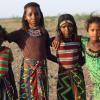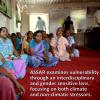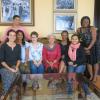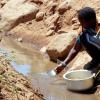Jump to: ASSAR's focus on gender and social differentiation | Key insights | Contact | News stories | Outputs
People’s vulnerabilities and responses to climatic and non-climatic risks, vary according to the way that social norms, market signals, laws and policies intersect with different dimensions of their identity. To avoid further marginalising the already vulnerable, we need to steer away from conventional approaches that focus on binaries of men and women, and move towards considering intersectional variables, that is, how aspects of age, ethnicity, class and marital status, amongst others, interact with gender to shape vulnerability and response strategies.

ASSAR’s focus on gender and social differentiation
One of ASSAR`s central questions was to understand how and why vulnerability is differentiated between communities and households (as well as within households), and to explore what this differentiation meant for coping and adaptation responses. We used mixed-methods research in rural, urban and peri-urban drylands to examine the socially-differentiated and gendered nature of vulnerability and adaptation. While focussing on household and intra-household vulnerability and adaptation, our research also made connections with broader environmental and socio-institutional dynamics to develop an understanding of vulnerability that is relational, dynamic, and embedded in wider political economy factors. Changes in rules, norms and practices in one institutional site could influence changes in other sites; however, the direction of change is unpredictable, and depends on power relations between individuals and groups. Our research highlights the structural constraints that depress women’s agency in semi-arid regions, be they unequal education and labour market opportunities, or the lack of child-care, health, drinking water, and sanitation services.
At the community level, our research approach included surveys and qualitative methods such as focus group discussions and life history interviews. We also brought different people together through India) in order to draw out which households were more vulnerable and why. Within households, we assessed the role of household structure and relationships between members in shaping power relations, agency, voice and aspirations, all of which determine whether people can or cannot respond to pressures. At an individual level, we demonstrated how women and men are not homogenous categories – their levels of vulnerability and abilities to respond to climate change impacts are differentiated by a combination of cultural, institutional, and demographic characteristics. Ultimately, the focus on intersecting identities allowed us to identify ways to support vulnerable women and men in local communities in addressing climate change impacts and the range of risks they are exposed to without compromising their wellbeing or exacerbating inequities.
Key insights
Men and women are not homogenous categories
Factors such as gender, age, marital status, and ethnicity or caste interact to shape how households manage risks. We see these multiple identities playing out differently in each context, affecting adaptive capacity to respond to climate-related risks.

Understanding intra-household dynamics is critical to adaptation
In semi-arid regions of Africa and Asia, severe pressure from climate change and other non-climatic stressors affects households – and the members within them – differently. Agricultural-based livelihoods and forms of diversification are associated with particular gender roles. Climate change in drylands is shifting the nature of responsibility sharing and cooperation in the household across gender and generations.
Women are not necessarily victims or powerless
Women in semi-arid regions of Africa and Asia are not lacking in their sense of agency, but in the context of stress and few livelihood options, their agency is directed towards short-term survival and coping. Supporting safe and remunerative livelihood diversification, and a renegotiation of power relationships to minimise unintended risks, are essential for making women critical agents of longer-term adaptation in a more equitable and inclusive manner.

Click here for more detail, and ASSAR's specific recommendations for policy, practice, and research
Contact
|
Nitya Rao* (n.rao@uea.ac.uk), University of East Anglia Margaret Angula (margaret.angula@gmail.com), University of Namibia Chandni Singh (csingh@iihs.ac.in), Indian Institute of Human Settlements |
Related news stories
Related outputs
|
Type |
Author(s) |
Year |
Title |
Details |
Links |
|---|---|---|---|---|---|
| Book chapter | D’Souza, M., Rao, B. and Awashi, S. | 2016 | Community-driven vulnerability assessment and resilience building: Cases from development contexts. | Managing the increasing heat stress in rural areas. | In: W. L. Filho (ed.) Handbook of Climate Change Resilience. Cham: Springer. |
| Book chapter | Singh, C . | _ | Of borewells and bicycles: The gendered nature of water access in Kolar, Karnataka and its implications on local adaptive capacity. | In: A. Hans, N. Rao, A. Prakash and A. Patel (eds.) En-gendering Climate Change: Learnings from South Asia. New Delhi, India: Routledge. | |
| Infographic | ASSAR | 2017 | Working towards more sustainable and equitable access to pasture in Kenya’s drylands. | ||
| Infographic | ASSAR | 2017 | Working towards more sustainable and equitable management of rangelands in Afar, Ethiopia. | ||
| Infographic | ASSAR | 2018 | Challenging assumptions about gender and climate adaptation. | Oshiwambo infographic | |
| Infographic | ASSAR | 2018 | Do women farmers have a fair share of land for food security and sustainable adaptation? | ||
| Infographic | ASSAR | 2018 | Dreaming of a better life: Let’s recognise and value people’s changing aspirations. | ||
| Infographic | ASSAR | 2018 | Gender is one of many factors that influence how we are impacted by and respond to climate change. | Oshiwambo infographic | |
| Infographic | ASSAR | 2018 | Household relationships help determine whether and how we can – or can’t – respond to pressures. | ||
| Infographic | ASSAR | 2018 | In semi-arid Ethiopia, gender and household relationships shape how we are impacted by and respond to climate change. | ||
| Infographic | ASSAR | 2018 | In semi-arid Kenya, gender and household relationships shape how we are impacted by and respond to climate change. | ||
| Infographic | ASSAR | 2018 | In semi-arid regions, women are not necessarily victims or powerless: They are often diversifying their livelihoods and increasing their agency. | ||
| Infographic | ASSAR | 2018 | Sometimes our interventions can lead to unintended consequences: A well does not always lead to wellbeing. | ||
| Information brief | ASSAR | 2018 | Do conservancies enhance the adaptive capacity of communities? Perspectives from ASSAR’s work in Kenya. | ||
| Information brief | ASSAR | 2018 | The gendered challenges of food security: Stories and lessons from ASSAR. | ||
| Information brief | ASSAR | 2018 | Women, work and adaptive capacity. | ||
| Information brief | ASSAR | 2019 | Adaptation is about people. | ||
| Information brief | Bosworth, B., Hegga, S. and Ziervogel, G. | 2018 | When participation is not enough: Lessons from decentralised water governance in Namibia. | ||
| Information brief | CARIAA | 2018 | Climate adaptation policy. | ||
| Information brief | Degefu, M. A., Assen, M. and Tesfaye, M. | 2019 | Prosopis juliflora: Impacts and management in the face of climate change in Ethiopia’s Middle Awash Valley. | ||
| Information brief | Few, R., Singh, C., Spear, D., Davies, J., Tebboth, M. G. L., Sidibe, A, Mensah, A. and Thompson-Hall, M. | 2018 | When adaptation barriers and enablers intersect: Key considerations for adaptation planning drawn from ASSAR’s findings. | ||
| Information brief | Michael, K., Singh, C., Deshpande, T. and Bazaz, A. | 2017 | Dimensions of vulnerability in rural and urban areas: A case of migrants in Karnataka. | ||
| Information brief | Pradyumna, A., Bendapudi, R., Zade, D. and D’Souza, M. | 2018 | Health vulnerability to heat stress in rural communities of the semi-arid regions of Maharashtra, India. | ||
| Information brief | Rao, N., Lawson, E. T., Raditloaneng, W. N., Solomon, D. and Angula, M. N. | 2016 | Gendered vulnerabilities to climate change: Insights from the semi-arid regions of Africa and Asia. | GSDR brief | |
| Journal article | Ahmed, A., Lawson, E. T., Mensah, A., Gordon, C. and Padgham, J. | 2016 | Adaptation to climate change or non-climatic stressors in semi-arid regions? Evidence of gender differentiation in three agrarian districts of Ghana. | Environmental Development, 20: 45-58. | Summary |
| Journal article | Few, R. and Tebboth, M. G. L. | 2018 | Recognising the dynamics that surround drought impacts. | Journal of Arid Environments, 157: 113-115. | Summary; Information brief |
| Journal article | Few, R., Morchain, D., Spear, D., Mensah, A. and Bendapudi, R. | 2017 | Transformation, adaptation and development: Relating concepts to practice. | Palgrave Communications, 3: 17092. | Summary |
| Journal article | Lawson, E. T., Alare, R. S., Salifu, A. R. Z. and Thompson-Hall, M. | 2019 | Dealing with a changing climate in semi-arid Ghana: Understanding intersectional perceptions and adaptation strategies of women farmers. | GeoJournal. | |
| Journal article | Michael, K., Deshpande, T. and Ziervogel, G. | 2018 | Examining vulnerability in a dynamic urban setting: The case of Bangalore’s interstate migrant waste pickers. | Climate and Development. | Summary; Information brief |
| Journal article | Morchain, D., Prati, G., Kelsey, F. and Ravon, L. | 2015 | Summary | ||
| Journal article | Morchain, D., Ziervogel, G., Spear, D., Masundire, H., Angula, M., Davies, J., Hegga, S. and Molefe C. | 2019 | Building transformative capacity in southern Africa: Surfacing knowledge through participatory Vulnerability and Risk Assessments. | Action Research, 17(1): 19-41. | Summary |
| Journal article | Rao, N. | 2019 | From abandonment to autonomy: Gendered strategies for coping with climate change, Isiolo County, Kenya. | Geoforum, 102: 27-37. | Presentation |
| Journal article | Rao, N., Lawson, E. T., Raditloaneng, W. N., Solomon, D., and Angula, M. N. | 2017 | Gendered vulnerabilities to climate change: Insights from the semi-arid regions of Africa and Asia. | Climate and Development. | Information brief |
| Journal article | Rivers III, L., Sanga, U., Sidibe, A., Wood, A., Paudel, R., Marquart-Pyatt, S. T., Ligmann-Zielinska, A., Olabisi, L. S., Du, E. J. and Liverpool-Tasie, S. | 2017 | Mental models of food security in rural Mali. | Environment Systems and Decisions. | Summary; Information brief |
| Journal article | Singh, C. | 2019 | Migration as a driver of changing household structures: Implications for household livelihoods and adaptation. | Migration and Development. | Summary |
| Journal article | Singh, C., Rahman, A., Srinivas, A. and Bazaz, A. | 2018 | Risks and responses in rural India: Implications for local climate change adaptation action. | Climate Risk Management, 21: 52-68. | Summary; Information brief |
| Journal article | Solomon, D. S. and Rao, N. | 2018 | Wells and wellbeing in South India. | Economic & Political Weekly, 53(17). | Infographic; Information brief |
| Journal article | Totin, E., Segnon, A. C., Schut, M., Affognon, H., Zougmoré, R. B., Rosenstock, T., and Thornton, P. K. | 2018 | Institutional perspectives of climate-smart agriculture: A systematic literature review. | Sustainability, 10(6): 1990. | Summary |
| Journal article | Wood, A., Rivers III, L., Ligmann-Zielinska, A. and Ansah, P. | 2019 | Examining climate change and food security in Ghana through an intersectional framework. | Journal of Peasant Studies. | |
| Journal article | Yidana, A., Mensah, A., Salifu, M. and Owusu, K. | 2018 | Social differences in the vulnerability and adaptation patterns among smallholder farmers: Evidence from Lawra District in the upper west region of Ghana. | Journal of Economics and Sustainable Development, 9(10): 175-187 . | Summary |
| Photo essay | Leavy, J. | 2018 | Changing aspirations and the realities of climate change adaptation for the young people in Ethiopia and Kenya. | ||
| Publication in progress | Alare, R. S., Lawson, E. T., Mensah, A., Ansah, P. and Adiku, P. | _ | Social networks, gender relations, and climate change adaptation in the semi-arid region of Ghana. | ||
| Publication in progress | Camfield, L., Leavy, J., Endale, S. and Tefere, T. | _ | ‘People who once had 40 cattle are left only with fences’: Coping with Persistent Drought in Awash, Ethiopia. | Presentation | |
| Publication in progress | Degefu, M. A., Assen, M. and Satyal, P. | _ | Villagisation and water resource in the Middle Awash Valley of Ethiopia: Implications for climate change adaptation. | Poster | |
| Publication in progress | Few, R., Satyal, P. and Tebboth, M. G. L. | _ | Using a justice/ capabilities framing to understand people's vulnerability and adaptive capacity in the drylands of East Africa. | ||
| Publication in progress | Few, R., Singh, C., Spear, D., Tebboth, M., Davies, J., Thompson-Hall, M. and Muhvich, K. | _ | The role of culture as a barrier and enabler to adaptation in semi-arid lands. | ||
| Publication in progress | Gitonga, Z. and Visser, M. | _ | Impact of migration on household social protection and wellbeing: An application of dose-response using control function approach. | ||
| Publication in progress | Hegga, S., Kunamwene, I. and Ziervogel, G. | _ | Local participation in decentralised water governance: Insights from north-central Namibia. | Presentation | |
| Publication in progress | Pillai, S. and Bendapudi, R. | _ | Inclusion of local aspirations in village development plans in Maharashtra. | ||
| Publication in progress | Rahman, A., Basu, R. and Singh C. I. | _ | Exploring the interface between climate change and migration: Evidence from India. | ||
| Publication in progress | Rahman, A., Singh, C. and Bazaz A. | _ | Climate change in urban areas: Differential vulnerability and adaptive actions in Bangalore. | ||
| Publication in progress | Rao, N. and Leavy, J. | _ | Domestic water, health and wellbeing: Gendered trade-offs in times of scarcity. Evidence from East Africa. | ||
| Publication in progress | Rao, N., Mishra, A., Prakash, A., Singh, C., Qaisrani, A., Poonacha, P., Vincent, K. and Bedelian, C. | _ | Women’s agency and adaptive capacity in climate change hotspots: A qualitative comparative analysis from Asia and Africa. | ||
| Journal article | Rao, N., Singh, C., Solomon, D., Camfield, L., Alare, R. S., Angula, M., Poonacha P., Sidibe, A. and Lawson, E. | 2020 | Managing risk, changing aspirations and household dynamics: Implications for wellbeing and adaptation in semi-arid Africa and India. | Summary; Presentation | |
| Publication in progress | Rao, N., Wasonga, O., Kibet, S. and A. Mizinova. | _ | Gendered conflict and cooperation in the context of pastoral vulnerabilities. | ||
| Publication in progress | Salifu, A., Lawson, E. and Wrigley-Asante, C. | _ | Social differentiation and adaptive responses adopted by farmers in a water scarce landscape: The case of groundnut farmers in the Lawra and Nandom Districts. | Poster | |
| Publication in progress | Satyal, P., Budds, J., Few, R., Bahir, A., Kibet, S. | _ | Adaptation to climate change in the context of decentralisation: Exploring multi-level governance of water-related issues in semi-arid areas of East Africa. | Presentation | |
| Publication in progress | Segnon, A. C., Achigan-Dako, E. G., Zougmore, R. B., Lokossou, J., et al. | _ | "Who you are, what you know and where your knowledge comes from affects what you do": Insight from climate change adaptation strategies in semi-arid areas of Mali. | ||
| Publication in progress | Segnon, A. C., Zougmore, R. B., Achigan-Dako, E. G., Ofori, B. D., Gordon, C. | _ | Harnessing agrobiodiversity for climate change adaptation in semi-arid areas of Mali. | ||
| Publication in progress | Shaibu, M. T., Onumah, E. E. and Al-Hassan, R. M. | _ | A comparative analysis of levels and intensity of adoption of climate change adaptation strategies among livestock farmers in North-West Ghana. | ||
| Publication in progress | Shaibu, M. T., Onumah, E. E., Al-Hassan, R. M. and Kuwornu, J. K. M. | _ | An assessment of vulnerability to climate change and its determinants among smallholder livestock farmers in Ghana’s Upper West Region. | ||
| Publication in progress | Sidibe, A., Sanga. U., Rajiv. P. and Olabisi, L. S. | _ | Translating mental models into system dynamics models for analyzing food security. | ||
| Publication in progress | Singh, C. and Basu, R. | _ | Moving in and out of vulnerability: Interrogating migration as an adaptation strategy along a rural urban continuum in India. | Summary | |
| Publication in progress | Sinha, B. and Bendapudi, R. | _ | Identifying differential vulnerabilities of rural communities in semi-arid region of Maharashtra through a wellbeing approach. | Poster | |
| Publication in progress | SK, N. | _ | Situating vulnerability in climate change adaptation research: Insights from India and Ghana. | ||
| Publication in progress | SK, N., Bazaz, A., Mensah, A., Scodanibbio, L., Tebboth, M., Few, R., Bendapudi, R., Rao, R., Badiger, S., Rao, N., Kibet, S., Wasonga, O. and Spear, D. | _ | Socially-differentiated vulnerability and adaptation practice in Africa and India. | ||
| Publication in progress | Solomon, D. and Badiger, S. | _ | Agrarian transformations: Impacts on wellbeing and adaptation outcomes in Western Tamil Nadu. | ||
| Publication in progress | Tebboth, M. G. L., Few, R., Assen, M. and Degefu, M. | _ | Valuing Prosopis juliflora? Analysing ecosystem service narratives to understand environmental management dilemmas. | ||
| Publication in progress | Tebboth, M. G. L., Singh, C., Spear, D., Mensah, A. and Ansah, P. | _ | The role of mobility in changing livelihood trajectories: Implications for vulnerability and adaptation in semi-arid regions. | Summary | |
| Publication in progress | Togarepi, C. and Nangolo, E. | _ | Gendered responses to climate change impacts on ecosystem services in north-central Namibia. | ||
| Publication in progress | Togarepi, C., Nangolo, E. and Gitonga, Z. | _ | Climate change impacts on livelihood strategies and food security in north-central Namibia. | ||
| Publication in progress | Wasonga, O., Kibet, S., Tebboth, M. G. L., Few, R. | _ | Do wildlife conservancies enhance the adaptive capacity of local communities? Perspectives from northern Kenya. | ||
| Radio/podcast | ASSAR | 2018 | Gender is one of many social factors influencing responses to climate change. | ||
| Report | ASSAR | 2019 | Participatory processes build adaptive capacity and agency and can help transform systems. | ||
| Report | Singh, C., Basu, R. and Srinivas, A. | 2016 | Livelihood vulnerability and adaptation in Kolar District, Karnataka, India: Mapping risks and responses. | ||
| Report | Tebboth, M. G. L. and Few, R. | 2018 | Considering the future of Prosopis: Participatory Scenario Analysis in Afar, Ethiopia. | ||
| Report | Tebboth, M. G. L. and Few, R. | 2018 | Considering the future of the rangelands: Participatory Scenario Analysis in Isiolo, Kenya. | ||
| Thesis | Akugre, F.A. | 2017 | Implications of land tenure rights on farmers’ adaptive capacity to climate variability and change in semi-arid North-Western Ghana: The case of crop farmers in the Lawra district. | Master's thesis. University of Ghana. | |
| Thesis | Angula, M. | _ | A gendered and intersectional analysis for understanding vulnerability to the changing climate within socially diverse Onesi constituency. | PhD thesis. University of Cape Town. | Poster |
| Thesis | Assabil, B. | 2017 | Women farmers’ perception to climate change/variability and their adaptation strategy in the Lawra district. | Master's thesis. University of Ghana. | |
| Thesis | Berthe, T. | 2016 | La Migration et la Variabilité de la Vulnérabilité des Groupes Sociaux: Cas du Village de M’Pessoba. | Master's thesis. Institut Universitaire de Développement Territorial de Bamako (IUDT. | |
| Thesis | Dakouo, J. | _ | Agriculture intensification pathways in Koutiala: Implications on access to agricultural natural resource base for different social groups. | Master's thesis. Université des Sciences Sociales et de Gestion de Bamako (USSGB). | |
| Thesis | Daou, J. | 2019 | Effects of agriculture intensification pathways on food, nutrition and income securities of social groups in Koutiala, Mali. | Master’s thesis. Institute Polytechnique Rural de Formation et de Recherche Appliquée (IPR-IFRA Katibougou, Koulikoro. | |
| Thesis | Kunamwene, I. | _ | Wellbeing as a way of looking at vulnerability and response to drought in Onesi, Namibia. | PhD thesis. University of Cape Town. | |
| Thesis | Lente, I. | 2017 | Poster | ||
| Thesis | Plea, A. | 2016 | Stratégie d’Adaptation des groupes sociaux face aux changements climatiques: Cas du maraîchage dans le village de Koumbri (Commune de Yognogo, Cercle de Koutiala). | Master's thesis. Institut Universitaire de Développement Territorial de Bamako (IUDT). | |
| Thesis | Sajith, S. | 2017 | Changing cropping patterns and its implications on household food security and nutrition. | Master's thesis. TERI School of Advanced Studies. | |
| Thesis | Salifu, A. R. | 2016 | Social differentiation in livelihood vulnerability and adaptation: A study of groundnut production in the upper west region. | Master's thesis. University of Ghana. | Poster |
| Thesis | Segnon, A. | _ | Exploring the role of agrobiodiversity in climate change adaptation in semi-arid areas of West Africa: A case study in Mali. | PhD thesis. University of Ghana. | |
| Thesis | Shaibu, M. T. | 2016 | Climate change adaptation strategies of small livestock farmers of Nandom and Lawra. | Master's thesis. University of Ghana. | Poster |
| Thesis | Sulemana, A. | 2017 | Management and use of non-timber forest products (NTFPs) as climate change adaptation strategy in Lawra district, Ghana. | Master's thesis. University of Ghana. | |
| Thesis | Traore, O. T. | 2016 | Gouvernance et vulnérabilité des groupes sociaux: Analyse de la situation institutionnelle autour du coton dans le Cercle de Koutiala. | Master's thesis. Institut Universitaire de Développement Territorial de Bamako (IUDT). | |
| Thesis | Yidana, A. A. | 2016 | Social differentiation in the vulnerability and adaptation patterns among smallholder farmers: Evidence from north western Ghana. | Master's thesis. University of Ghana. | |
| Video | ASSAR | 2015 | Understanding gender in the context of climate and development. | ||
| Video | ASSAR | 2017 | Experiential learning: Vulnerability Walk. | ||
| Video | ASSAR | 2018 | Empowering women leaders in Ghana’s Upper West region to adapt to climate change. | ||
| Video | ASSAR | 2018 | Under the blazing sun. | ||
| Video | ATREE | 2019 | Wells and a lack of wellbeing. | ||
| Webinar | ASSAR | 2018 | Challenging assumptions about gender and climate adaptation: It’s not always what, or who, you think. | ||
| Webinar | CARIAA | 2016 | What if gender became an essential standard element of vulnerability assessments? | ||
| Working paper | Basu, R. and Bazaz, A. | 2016 | Assessing climate change risks and contextual vulnerability in urban areas of semi-arid India: The case of Bangalore. | ||
| Working paper | Few, R., Satyal P., Assen M., Camfield L., Leavy J. and McGahey D. | 2018 | The development-adaptation spectrum in dryland East Africa: mapping risks, responses and critical questions for social research. | ||
| Working paper | Few, R., Satyal, P., McGahey, D., Leavy, J., Budds, J., Assen, M., Camfield, L., Loubser, D., Degefu, M. A. and Bewket, W. | 2015 | Vulnerability and adaptation to climate change in the semi-arid regions of East Africa. | ||
| Working paper | Misquitta, K. and Thatte, K. | 2018 | Whose appropriate technology? Understanding the adoption of micro-irrigation in the face of climate and policy uncertainty. | ||
| Working paper | Phadtare, A., Banerjee, S. and Bendapudi, R. | 2019 | Are changes in land use land cover influencing gender dynamics in semi-arid areas. | ||
| Working paper | Pradyumna, A., Bendapudi, R., Zade, D. and D’Souza, M. | 2018 | Heat stress – vulnerability, health impacts, and coping strategies in rural communities in the semi-arid region of Maharashtra, India. | ||
| Video | ASSAR | 2019 | A focus on wellbeing can link adaptation to outcomes that matter to people. |










